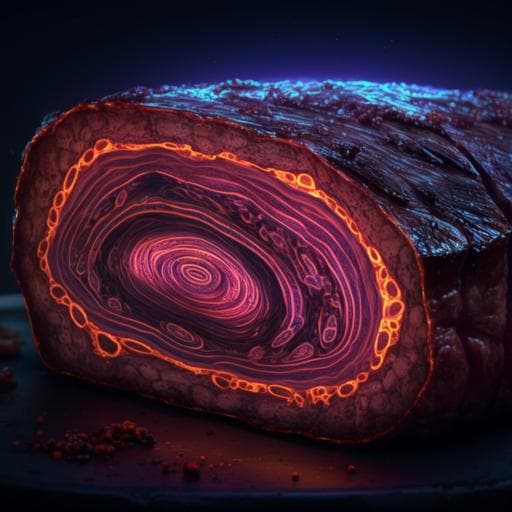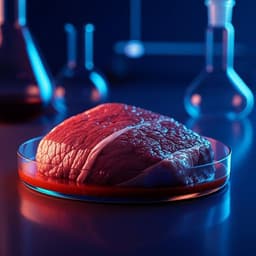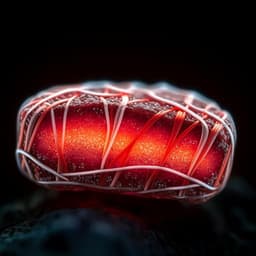
Food Science and Technology
Production of scaffold-free cell-based meat using cell sheet technology
R. Tanaka, K. Sakaguchi, et al.
This groundbreaking study by Ryu-ichiro Tanaka, Katsuhisa Sakaguchi, Azumi Yoshida, Hironobu Takahashi, Yuji Haraguchi, and Tatsuya Shimizu explores the innovative production of scaffold-free cell-based meat using cell sheet technology. The 3D tissue created from bovine myoblast cell sheets demonstrates increased hardness after boiling and paves the way for an eco-friendly alternative to traditional beef.
~3 min • Beginner • English
Introduction
Global meat demand is rising with population growth, but conventional livestock production contributes substantially to greenhouse gas emissions (about 14.5% via feed production and manure management), land and water use. Cell-based meat offers a more sustainable alternative with reduced environmental impacts. Three-dimensional tissues for cultured meat can be produced using scaffold-based or scaffold-free approaches; however, many reported scaffolds rely on animal-derived proteins, conflicting with sustainability goals. Cell sheet technology provides a scaffold-free method to create high-cell-density, millimeter-thick tissues by detaching intact cell sheets from temperature-responsive culture dishes (TRCDs) and stacking them. The study aimed to produce scaffold-free cell-based meat from bovine myoblast cell sheets, evaluate its texture (including heating effects) and nutrient composition, and demonstrate scalability by enlarging the TRCD size.
Literature Review
Prior work in tissue engineering has established methods to fabricate 3D skeletal muscle using scaffolds (e.g., gelatin, tendon-gel integrated bioprinting, textured soy protein) that impart meat-like structure but often depend on animal-derived materials. Cell sheet engineering, enabled by surfaces grafted with poly(N-isopropylacrylamide) (PIPAAm), allows temperature-controlled cell attachment/detachment, preserving cell-cell and cell-ECM contacts and enabling stacking into thick tissues. Cell sheet methods have been used to generate functional skeletal muscle, liver, and cardiac tissues for regenerative therapy and drug screening. These advances suggest that scaffold-free, scalable constructs are feasible for cultured meat applications, potentially reducing reliance on animal-based scaffolds.
Methodology
Cell source and isolation: Bovine myoblasts were isolated from bovine cheek muscles. Minced tissue was digested with pronase at 37 °C for 1 h, filtered (40 µm), centrifuged (1000 × g, 10 min), and cultured in DMEM with 10% FBS, antibiotics, and 10 ng/ml bFGF on laminin-511–coated 10 cm dishes. Medium was changed every 2–3 days, and cells were passaged at confluence (day 6–7).
Cell sheet preparation: For standard sheets, bovine myoblasts were seeded on 3.5 cm temperature-responsive culture dishes (TRCDs; PIPAAm-grafted) coated with laminin-511 in DMEM +10% FBS +1% Pen/Strep. Cells were cultured at 37 °C with medium changes after seeding and on day 4. Cell sheets were detached by lowering temperature to 20 °C for 30 min on day 1, 3, or 7 after seeding. For large-sized sheets, 10 cm TRCDs were used with 3 × 10^7 cells/dish and 10 ml medium; sheets were detached after 1 day (20 °C for 30 min).
Stacking to form 3D tissues: Two myoblast cell sheets were overlaid in a dish and incubated at 37 °C for 15 min to adhere. Additional sheets were added iteratively to form 10-layer constructs (standard size). Large-sized constructs were prepared similarly with 8, 10, or 12 layers. Some large constructs were fixed in 4% paraformaldehyde and optionally colored with food dye for demonstration.
Reuse of TRCDs: After harvesting 1-day sheets, used TRCDs were ultrasonically washed in chilled ultrapure water (20 min, <20 °C), sterilized with 70% ethanol, rinsed in PBS, and reused to prepare additional sheets. Reuse was validated up to two times.
Dimensional measurements: Sheet diameter was calculated from plan area (ImageJ). Thickness of single and stacked sheets was measured by optical coherence tomography (three cross-sections per sample, five measurements per image). Volume of 10-layer constructs was computed as π(D/2)^2 × thickness.
Texture profiling (TPA): A texture analyzer with a 10 mm circular probe compressed samples twice at 0.04 m/s to depths of 0.3–2 mm. For heating, raw stacked sheets were boiled in water at 85–90 °C for 90 s. Commercial beef slices (1–2 mm thickness) were tested similarly in raw and boiled states. Output metrics included hardness (peak stress on first compression), elastic modulus (slope of stress–strain), and Szczeniak-defined parameters: cohesiveness, springiness, chewiness, brittleness, and adhesiveness.
Histology and immunostaining: 4% PFA-fixed sheets were paraffin-embedded (5 µm). HE and AZAN staining assessed structure and collagen fibers. Immunofluorescence for myoblast markers PAX7 (1:200) and MYOD (1:200) was performed with Alexa Fluor–conjugated secondary antibodies. Cytoskeletal F-actin content was assessed by phalloidin staining of cells cultured 1 vs 7 days on laminin-511–coated plates, counterstained with Hoechst.
Nutritional analyses: Day 1 and day 7 stacked sheets and minced bovine cheek meat were weighed (wet), freeze-dried (dry weight), homogenized in saline by ultrasonication. Total protein was quantified by Bradford assay (absorbance 595 nm). Carbohydrates were measured by phenol–sulfuric acid method (490 nm) using glucose standards. Unsaturated fatty acids were quantified by vanillin–sulfate method following lipid extraction, reading at 540 nm with lipid standards.
Statistics: One-way or two-way ANOVA with Tukey’s post-hoc tests were used (GraphPad Prism 9). Significance thresholds as reported in figures.
Key Findings
- Fabrication and morphology: Ten stacked bovine myoblast cell sheets produced 3D tissues 1.3–2.7 mm thick. Measured diameters decreased with culture time: day 1, 14.7 ± 0.6 mm; day 3, 12.2 ± 0.7 mm; day 7, 11.2 ± 0.7 mm. Single-sheet thickness increased: 0.12 ± 0.01 mm (day 1), 0.14 ± 0.01 mm (day 3), 0.17 ± 0.04 mm (day 7). Ten-layer thickness: 1.43 ± 0.11 mm, 2.04 ± 0.01 mm, 2.28 ± 0.39 mm for days 1, 3, 7, respectively. Ten-layer volumes were not significantly different across days (~246, 238, 229 mm^3). F-actin content increased by day 7; sheets were predominantly PAX7- and MYOD-positive myoblasts. AZAN staining showed no detectable collagen fibers. TRCDs were reusable up to two times.
- Texture properties: Hardness increased with culture duration and further increased after boiling. Day 1: raw 2.80 ± 1.05 kPa vs boiled 5.00 ± 1.31 kPa (significant). Day 7: raw 9.07 ± 5.11 kPa vs boiled 14.69 ± 7.03 kPa (significant). Elastic modulus similarly increased with culture time and heating. Compared to day 7 sheets, commercial beef (1–2 mm slices) had much higher hardness and modulus: raw beef hardness 87.19 ± 18.93 kPa (~9.6× higher), boiled beef 241.55 ± 88.88 kPa (~16.5× higher); elastic modulus raw 13.22 ± 1.28 kPa (~14.2× higher), boiled 22.66 ± 3.99 kPa (~23.22× higher).
- Additional TPA metrics: Cohesiveness showed no significant differences across sheet culture days (raw or boiled) but differed from beef, especially post-heating. Springiness trends varied with day and heating without significance. Chewiness tended to increase with culture time. Brittleness decreased with culture time and was not observed in boiled day 7 sheets; beef showed lower brittleness than sheets, further reduced after heating. Adhesiveness of sheets was largely unchanged by day or heating; beef adhesiveness tended to decrease after heating.
- Nutritional composition: Water content was higher in sheets (day 1: 87.5 ± 0.4%; day 7: 88.1 ± 0.6%) than in beef (60.0 ± 6.4%). Total protein (wet weight): sheets 6.3 ± 1.1% (day 1) and 5.0 ± 0.5% (day 7) vs beef 11.3 ± 0.9%. Total protein (dry weight): sheets 50.6 ± 7.9% (day 1) and 42.3 ± 6.1% (day 7) vs beef 28.8 ± 5.4% (sheet day 1 significantly higher). Carbohydrates (wet): sheets 1.2 ± 0.2% and 1.3 ± 0.2% vs beef 0.9 ± 0.1% (slightly but significantly lower in beef). Carbohydrates (dry): sheets 9.7 ± 1.5% and 10.9 ± 1.4% vs beef 2.2 ± 0.4% (sheets significantly higher). Unsaturated fatty acids (wet): sheets 0.2 ± 0.1% (both days) vs beef 0.8 ± 1.2%. Unsaturated fatty acids (dry): sheets 2.0 ± 0.6% and 2.0 ± 0.5% vs beef 2.5 ± 3.8% (large variation in beef).
- Scalability: Large-sized cell sheet-based meat was produced by stacking up to 12 sheets from 10 cm TRCDs, demonstrating simple scale-up by increasing TRCD area.
- Production time estimate: Approximately 2.9 × 10^11 cells are required for 1 kg of cell-based meat if cell size is constant; with myoblast doubling times of 2–3 days, expansion to the required cell numbers was estimated to take roughly 29–47 days.
Discussion
The study demonstrates that scaffold-free cell sheet technology can produce stacked myoblast tissues resembling aspects of meat structure and behavior, addressing the sustainability goal of reducing animal-derived scaffold materials. Mechanical properties improved with culture duration and heating, paralleling natural meat behavior, and likely reflect increased intracellular F-actin rather than collagen deposition, which was absent. While absolute hardness and modulus remain far below those of beef, results suggest routes to texture enhancement: promoting collagen secretion (e.g., via cytokines or mechanical stimuli), aligning myoblasts, inducing myotube formation, and applying electrical/mechanical conditioning. Heating-induced hardening in sheets, analogous to protein denaturation and aggregation in meat, supports the relevance of intracellular protein transitions to texture. Nutritional analyses show higher water content and lower wet-weight protein compared to beef, but higher protein on a dry-weight basis; higher carbohydrate content likely reflects glycogen from high-glucose culture media, which could be modulated by media formulation to tailor nutritional profiles. Unsaturated fatty acid content in sheets reflects membrane phospholipids; variability in beef metrics underscores cut-to-cut differences. From a sustainability and safety perspective, the approach reduces reliance on animal-derived scaffolds and can scale with larger TRCDs; future equipment could transition from plastics to PIPAAm-grafted metal or glass to reduce environmental impact and contamination risks. Ensuring food safety will require adherence to standard food regulations, including repeated-dose toxicity testing, given the potentially large consumption volumes.
Conclusion
Scaffold-free cultured meat constructs were fabricated by stacking bovine myoblast cell sheets detached from temperature-responsive culture dishes. The resulting tissues reached millimeter-scale thickness, exhibited increased hardness with culture duration and upon boiling, and showed distinct nutrient profiles relative to beef. The method scales by simply increasing TRCD area, supporting feasibility for larger formats. Future work should focus on enhancing texture through myotube formation, alignment, collagen deposition, and biophysical stimulation; optimizing media to tailor protein, glycogen, and lipid content; transitioning equipment toward reusable metal or glass TRCDs; and performing comprehensive food safety assessments. These advances will further position cell sheet-based meat as a sustainable alternative to conventional meat.
Limitations
Mechanical properties of stacked sheets remain substantially lower than those of beef. Constructs were composed primarily of undifferentiated myoblasts without myotube formation or collagen fibers, limiting texture. Wet-weight protein comparisons may be confounded by different handling (cell sheets washed with PBS; beef stored in air) and higher water content in sheets. Sample sizes were modest (e.g., n=4 for texture of sheets, n=6 for beef), and only a single cell type and species were tested. TRCD reuse was demonstrated only up to two cycles. Growth on TRCDs was overconfluent with limited proliferation, necessitating separate expansion steps. Beef composition varies by cut and individual, influencing comparative nutrient and texture metrics. Sensory properties, cooking beyond brief boiling, long-term culture effects, vascularization, and comprehensive safety testing were not evaluated.
Related Publications
Explore these studies to deepen your understanding of the subject.







